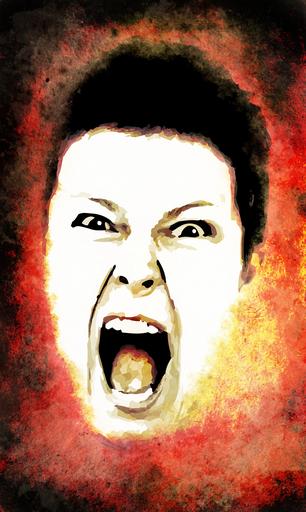
You did it. You lost your temper and turned into a Hulk, a witch, fiery-dart breathing dragon, and you crushed your little loved ones’ spirits, you spanked their little bottoms, or maybe you shook, or slapped, or threw things, definitely yelled and said vile things about how awful they are. The angry words came out faster than you could catch them. And now you feel horrible. You are the worst mother ever. Your poor terrified kids would be better off in an orphanage than living with you. They cry. You cry. And the worst part is, this is a normal day.
Mommy rage. We know it’s bad. What we don’t know is how to change ourselves into the patient, loving, long-suffering, unflappable mother we long to be. All we know to is to try harder. Next time we won’t let ourselves get angry. We’ll show more self-control. We won’t ever let ourselves act like that again. But we do. You may have been a calm, serene person BC (before children), but somehow kids help us discover the temper we never knew we had.
Things kids do that push the anger buttons:
Babies: cry non-stop, cry because they are too tired to eat and too hungry to sleep, make a diaper change a wrestling match, won’t nurse, have colic, won’t sleep when you are exhausted.
Toddlers: whine, throw a tantrum because you cut his sandwich in squares instead of triangles, insist on putting on her own socks and melt down because they won’t go on, paint the brown couch in a rental with red oil paint (true story), refuse to eat, refuse to nap, scribble on the walls, cut their hair, dig the dirt out of a potted plant, climb to the top shelf, run into the street, destroy something you value, poop in their bedroom and then paint the walls with it, pour the bottle of vegetable oil on the floor and skate in it (another true story).
School aged children: whine, fight with each other because “He’s breathing on me.”, talk back, ignore you when tell them what to do, won’t get ready in time, lie, steal, can’t find their shoes when it’s time for school, don’t do their chores, need constant help with their homework.
Teenagers: wear inappropriate clothing, sass, ignore chores, ignore homework, ignore anything you say, stay out too late, chose horrible friends, live on their phones or tablets, whine, argue about everything, smoke, drink, fight, use drugs or have sex.
Pair these triggers with never-ending dirty dishes, piles of laundry, not enough sleep, not enough money, not enough time for all you have to do, and even the most mild-mannered mom can turn into a screaming maniac. Barnhill, who wrote She’s Gonna Blow! Real Help for Moms Dealing with Anger, says it’s often the ‘little’ things in our everyday lives that are the most likely to send us over the edge.1
“Anger is the most powerful of all emotional experiences… The only emotion that activates every muscle group and organ of the body, anger exists to mobilize the instinctual fight-or-flight response meant to protect us from predators.”2 But our children aren’t predators.
The funny thing about anger, as strong as the emotion is, it is often a secondary emotion, one we experience because we aren’t dealing with the primary emotion. Most often our anger comes because of fear. We fear our children will get hurt or will hurt someone else, we fear looking like a failure, we fear they won’t love us, that they’ll bomb out at school and thus life, that they’ll grow up to be liars or thieves, or living on the streets.
Other emotions that can hide under anger are hurt, frustration, disappointment, grief, guilt, loss, or a feeling of inadequacy, or even the unfinished business of your own childhood. For example, “for some people, a crying baby becomes a signal not of the child’s needs but of the parent’s abject failure. The inability to comfort a distressed baby, or at least to stop the crying, is the leading cause of child abuse, shaken-baby syndrome, and infanticide.”2 Psychologist Gary J. Oliver explains, “At a very early age, many of us learned that anger can help us divert attention from these more painful emotions. Anger is safer.”3 It may be that our anger simply stems from feeling overwhelmed, fatigued, or burnt out.
For me, the underlying emotion was fear of loss of control. I was under the mistaken belief that my job was to make my children be good. With my compliant children, it was easy. I told them what to do, they did it, and I was a good mom. With my non-compliant children, it was different. I told them what to do, they did something else, and I was a failure as a mom. I couldn’t make them do anything. So I got angry.
What do we do with our anger? We can stuff it, which can make us emotionally and even physically sick, and which can slowly build inside us until it explodes, blowing our children up along with us. Or we can unleash it immediately on our poor scared children, often being cruel, critical and hostile. Another way anger is often expressed is passive-aggressive behavior. Procrastination, sarcasm, emotional withdrawal, lack of consideration, and the silent treatment make our point. Oliver and his co-author H. Norman Wright tell us it rarely helps to “try hard” to stop being angry. We need more than self-control.3
Oliver tells us that simply feeling the emotion of anger is not wrong.2 It can be an important message that… our needs or wants are not being fully met. To keep from hurting those we love, and ourselves, we need to look closely to understand what is really underneath our anger—our fear, our frustration, our hurt—and choose to talk about those emotions instead. It is an opportunity for emotional growth. When those emotions are healed, there is no need for the anger. “Talking about these ‘softer’ primary emotions tends to prompt softer language from us that’s less threatening to others.”3
I used to get really angry at my 4-year-old son for riding his Big Wheel in the street. Yelling at him didn’t seem to make any difference. When I explained that I was afraid he would be hit by a car and badly hurt, he explained to me that he was faster than any car. A short race down the block between me in the car and him on his Big Wheel, demonstrated that the car really was faster, and after that he stayed out of the street. Expressing my fear worked better than expressing my anger.

Tricia Jalbert in her blog Mommy Rage: Cool Down Before You Melt said, “Children learn from watching how you deal with your own feelings and how you deal with theirs. While you wouldn’t want to saddle your child with inappropriate exposure to your adult issues and emotions, it is not unhealthy for them to simply see you angry. It’s what you do when you are angry, and how you manage your intensity, that are important. Showing healthy responses to strong emotions teaches children that these emotions can be expressed and managed safely.”4
What are healthy responses to that dangerous fire of anger inside ourselves?
Give yourself a time out. Go ahead and tell your kids that you are angry and need time to cool off and you’ll talk to them later. Exercise, punch a pillow, scrub something to get rid of the toxic chemicals flooding your body from anger. See if you are tired, or hungry, or lonely, and if so, take care of it. Consciously relax. Tense and relax all your muscles, one at a time. Try creative projects or meditation. I used to go into my bedroom and pray that my anger could be replaced with love and I could look for teachings and solutions rather than punishment.
Force a smile. Mom Tara Giroud said, “I used to think [a forced smile] was the stupidest thing, but lately when I’m five-miliseconds from exploding, I turn around and force a smile and within seconds I can feel a shift. I can breathe. I can come back into my somewhat more rational self. I can turn back to my kids and not roar my terrible roar or gnash my terrible teeth.”5
Speaking of which, work to avoid scaring your children. You can honestly express your feelings without being scary. Really.
You can also express anger without blame or labeling. “I feel angry when you keep fighting,” rather than “I can’t stand you, you are such a trouble maker.”
Don’t take it personally. We sometimes see disobedience as a personal insult. We say do this, and they do that. Remember, they are just children. They aren’t out to get us. They are just seeing things from their undeveloped viewpoints, which is all about them, not us.
Girard warns us about counting to ten. According to one report, it actually makes people angrier. We don’t want that. Taking deep breaths is good if you focus on the breathing out rather than sucking the air in. Taking a deep breath in may trigger the fight or flight response. Instead, focus on blowing all the air out of your lungs. This moves you into a more rational part of your mind.
Think ahead and look for potential anger situations and avoid them if possible, or visualize possible better responses.
“The difference in your reaction to the child’s behavior lies entirely within you and depends completely on how you feel about yourself, says Steven Stosny, Ph.D. [If your self-value is low], the child’s behavior seems to diminish your sense of self, and in anger you punish him for doing it to you. [When self-value is high], the child’s behavior does not diminish your sense of personal importance, value, power, or lovability. So there is no need for anger. Rather, the problem to be solved is how to teach the child to behave better; you won’t do that by humiliating or scaring him with anger. His reaction to humiliation and fear will be the same as yours—an inability to see the other person’s perspective, an overwhelming urge to blame, and an impulse for retaliation or punishment.”2

Remember we are a work in progress as parents. We’re not going to be perfect all at once. I’ve been a mom for 56 years, and I’m still not perfect (don’t tell my kids. Oh wait, they already know). So at some time or another, our toddler is going to scribble on the wall or our teen is going to come home at 4 am, and we’re going to lose it and morph into that fiery dragon again. When that happens, we can quickly admit that we have been wrong. We can and should apologize to our children. We can talk about the underlying emotion that led us to the anger. We tell our child how we are feeling now (sorry, embarrassed, guilty, etc.). We can talk about what we should have done to calm down before we lost it. We can brainstorm with our child about avoiding future bouts of anger. Your child can learn an invaluable life skill by this type of interchange. You model for them how to handle it when they lose their temper. Win-win.
- Focus on the Family When Moms Get Angry by Carol Steffes
https://www.crosswalk.com/family/parenting/when-moms-get-angry-1201796.html
- Psychology Today Why Parents Really Get Angry at Their Kids.by Steven Stosny, Ph.D., posted Aug 07, 2015
- Why moms who struggle with anger need to be brave by Catherine Wilson https://www.focusonthefamily.ca/content/why-moms-who-struggle-with-anger-need-to-be-brave
- The Snap Mom Mommy Rage Cool Down Before you Melt by Tricia Jalbert
https://thesnapmom.com/mommy-rage-cool-down-before-you-melt/
- Walking on travels: Hey you, Angry Mom, you’re not alone by Tara E. M. Giroud, posted Feb. 20, 2017 in MOM, Parenting
https://walkingontravels.com/mom/hey-you-angry-anger-mom-youre-not-alone/
